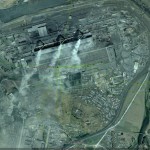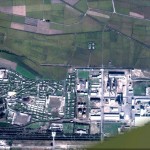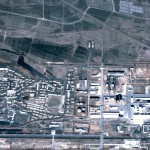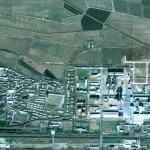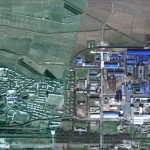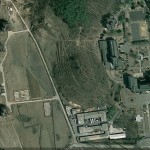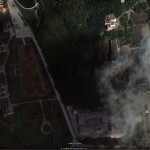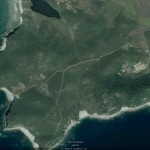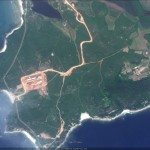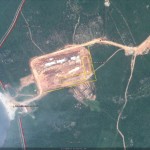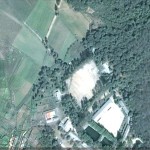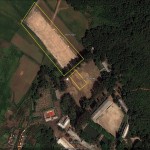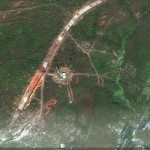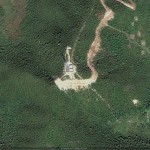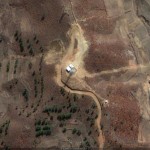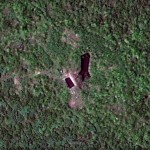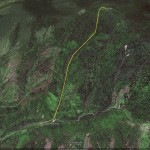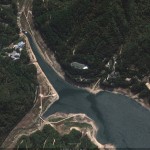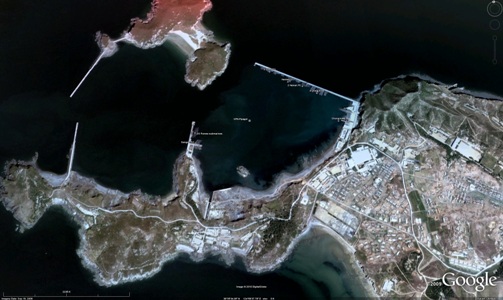Pictured above (Google Earth): Pukchang Thermal Power Plant (북창화력발전련합기업소)
According to the Daily NK:
A source from Pyongyang reported the latest on the 14th, saying, “From April the electricity situation got a bit better, so now between 8 in the morning and 5 in the afternoon the electricity goes on and off repeatedly.”
But, the source added, “Between 10 at night and 5 in the morning, it is provided stably.”
According to the source, in the winter period from January to March, electricity was only supplied at all between midnight and 4 or 5 in the morning.
Residential areas of the city receive their electricity mostly at night because factories and official buildings are prioritized during daylight hours.
However, if, for instance, from 8 A.M. to 12 P.M. electricity goes to a shoe factory, and then from 12 P.M. to 5 P.M. it goes to a fabric factory, people in the neighborhood of those factories might be able to charge batteries or watch DVDs during that time.
However, outside the capital things are worse, as usual. In the case of Nampo on the West Sea coast, there is almost no daytime electricity supply at all. According to a source from the city, “In general there is no electricity. It comes around two days in ten, but even at those times it doesn’t usually work for longer than two hours.”
“The electricity situation is getting worse, and people say this is because electricity generated at Bukchang [Pukchang, 북창] Power Plant is all sent to Gangsun Steel Mill,” the source added.
Hyesan in Yangkang Province is in much the same boat. When Kim Jong Il conducted an onsite inspection at Hyesan Youth Mine in April the authorities provided the area with electricity, but now it never comes.
A Hyesan source explained, “They send electricity for 24 hours on Kim Il Sung and Kim Jong Il’s birthdays, but this year it was unstable even then. When May came, they started to give us electricity from 6 to 10 in the evening, but it is unstable so for houses with no transformer this electricity is useless.”
The source from Nampo reported that some wealthier people apparently used to get electricity by offering money to local factories, approximately 15,000 won per month, but that this avenue has also been closed off.
The practice stopped when a decree was handed down stating, “Those who use stolen electricity will be exiled.”
There is also the ongoing problem of copper theft, the Nampo source revealed, explaining, “Before April 15th this year, electrical cables were stolen from Nampo Samcheon-ri Chosun-China Joint Factory (a clothing factory), so for five days the factory couldn’t operate. The workers chipped in with around 300 to 500 won each from their wages to purchase cables so that electricity could come again.”
Since electricity does not flow in most cables continually, it is easy to sever them to obtain the saleable copper inside. This copper, which is relatively expensive, is then sold to smugglers who sell it in China.
The “Gangsun Steel Mill” (Kangson Steel Mill) is now the “Chollima Steel Mill” and it was home to the Chollima Movement (learn more here). It is true that the DPRK has been recently emphasizing steel production (via recycling of scrap), but it is strange that people would literally think it is draining all the power from the Pukchang Thermal Power Plant since the two facilities are not directly connected on the power grid (or even close to each other). It is pretty obvious from Google Earth imagery that the steel mill receives its power from the Pyongyang and East Pyongyang Thermal Power Plants. It could be that the reference to the “Kangson Steel Mill” (which is itself interesting since the factory has not gone by that name in years) is a generic reference to the state’s prioritization of heavy industry over houshold electricity use.
Read the full story here:
Electricity Supplies Showing No Big Improvement
Daily NK
Lee Beom Ki and Jeong Jae Sung
2011-5-16
